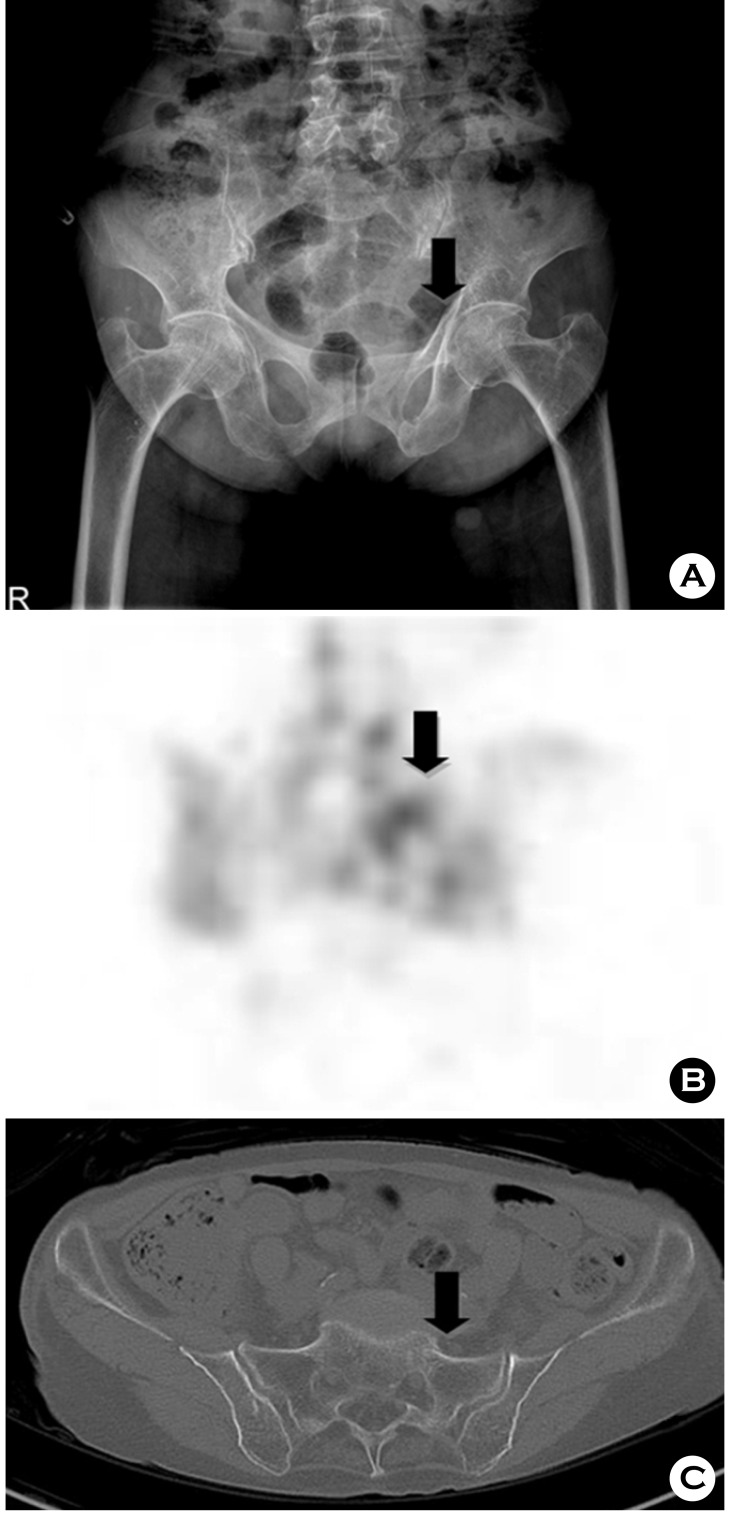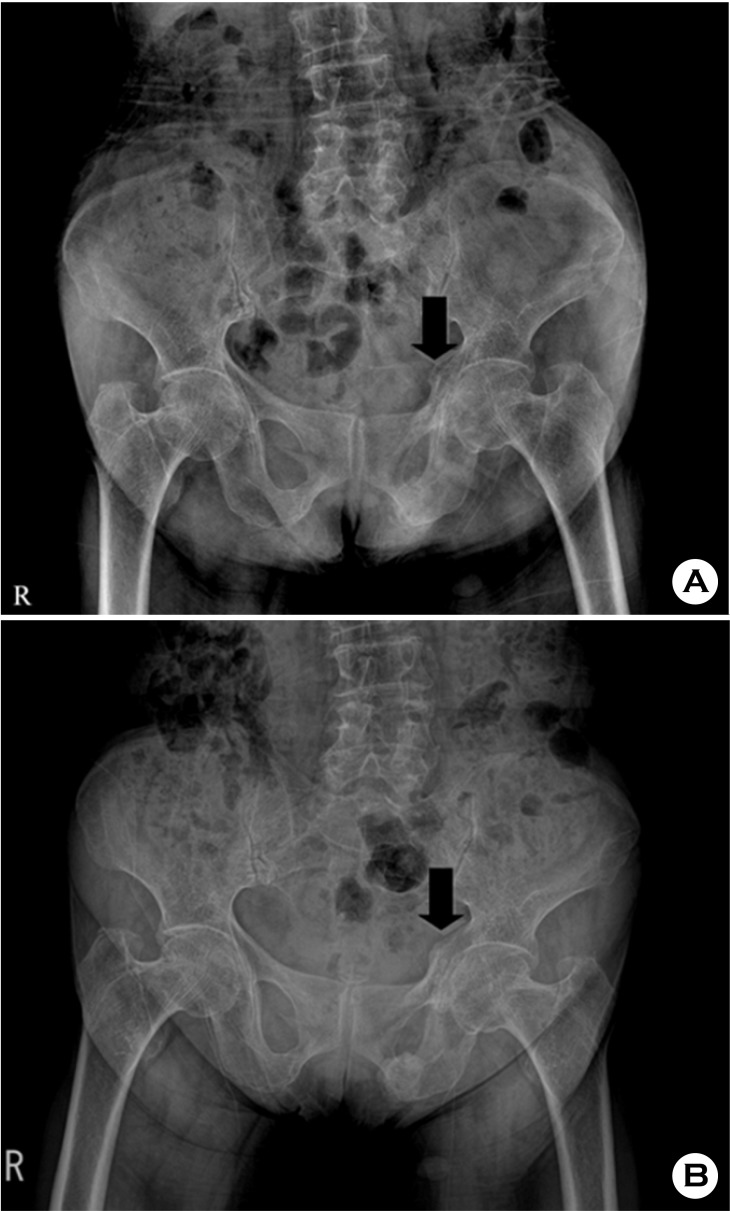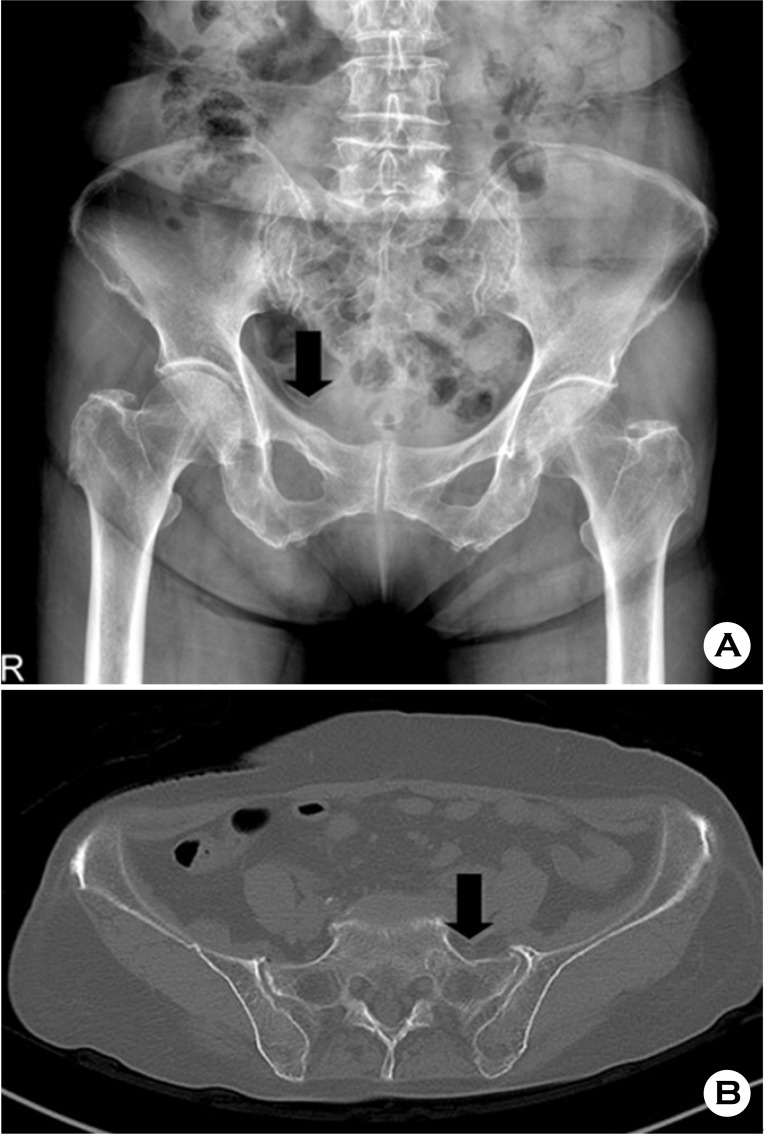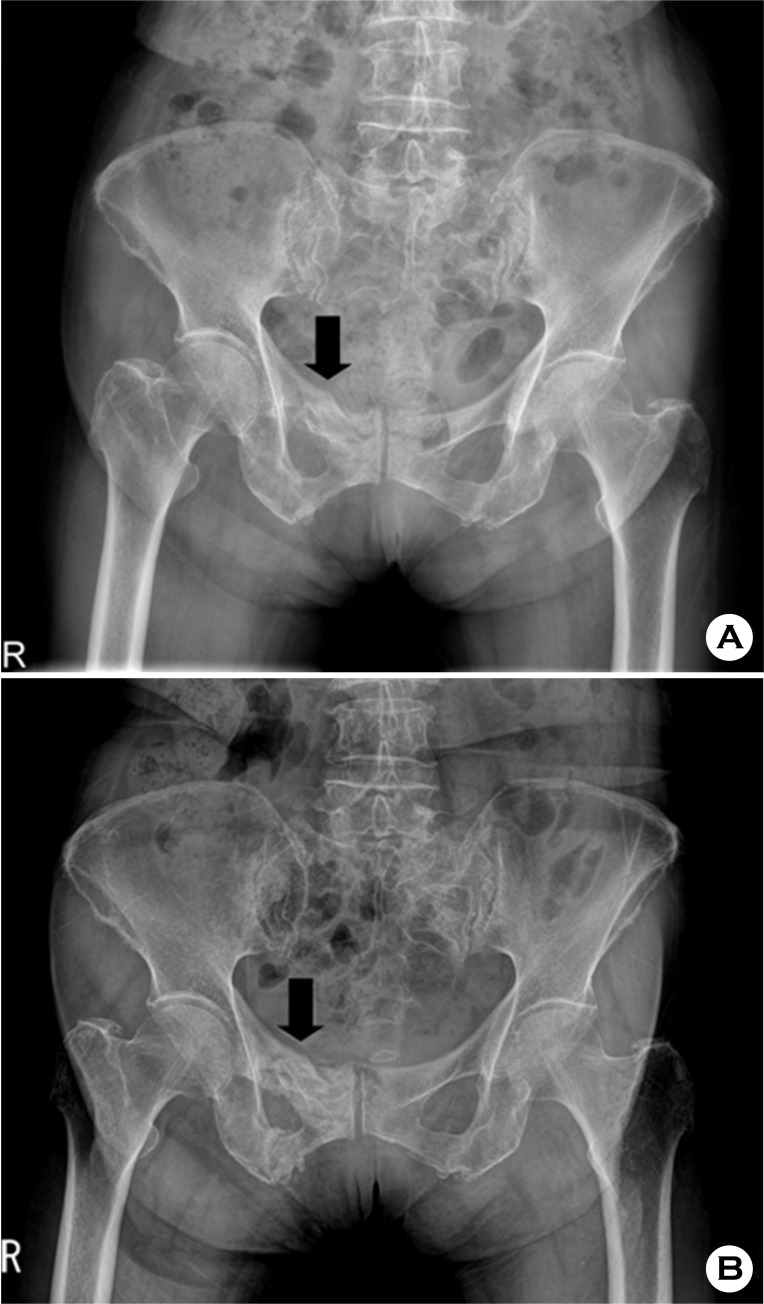Abstract
As a result of aging population, the incidence of pelvic insufficiency fracture has been increasing. Pain-related immobility caused by pelvic insufficiency fractures may result in a serious dependency and high mortality with preexisting comorbidities. We present two cases of pelvic insufficiency fracture in elderly patients which had good clinical outcome by parathyroid hormone 1-34(teriparatide) treatment as well as a literature review.
Keywords: Osteoporosis, Parathyroid hormone, Pelvis, Pelvis (Pelvic) insufficiency fracture
INTRODUCTION
Pelvic insufficiency fractures are common in female patients with osteoporosis and mostly occurred by trivial injury or slip down. As elderly population increases, the incidence of pelvic insufficiency fractures tends to be also increased rapidly.[1,2] If pelvic insufficiency fractures occur in elderly population, it leads to increase in dependency by mobility reduction in patients and then mortality rate also increases due to aggravation of medical comorbidities.[3] However, diagnosis and treatments are easily missed for the pelvic insufficiency fractures occurred in elderly population. The aim of treatments for pelvic insufficiency fractures is to let patients walk early with bed rest and medication for pain relief. As we obtained outstanding clinical outcome such as early pain relief and walk utilizing parathyroid hormone (PTH) 1-34(teriparatide) in pelvic insufficiency fractures, we present the cases as well as a literature review.
CASE REPORT
Case 1
The patient was a 76 year old female and visited outpatient clinic due to the left hip pain that was occurred after a fall (slip down). Fractures in left pubic ramus were observed on simple radiograph at the admission and fractures in sacrum left side were found in bone single photon emission computed tomography (SPECT) and computed tomography (CT) scan (Fig. 1). In bone mineral density examination utilizing dual-energy X-ray absorptiometry (DXA; Prodigy Advance™, GE-Lunar Corp., Madison, WI, USA), osteoporosis was diagnosed with T-score -5.2 (L1-4) but the patient didn't have history of diagnosis and treatments in osteoporosis before the injury. Although teriparatide was only allowed for the treatment of osteoporosis in Korea, the patient was given 20 µg of teriparatide (1-34 PTH, Forsteo®) subcutaneously once a day in order to promote fracture healing as well as treat osteoporosis. Teriparatide was administered for 8 weeks. Bed rest and medication for pain relief was combined at the same time; tramadol 50 mg (Tridol®) was injected intravenously twice, morning and night, a day for seven days and transdermal fentanyl patch 12 µg/hr (Durogesic® DTrans®) was administered every 72 hours for 4 weeks. Pain visual analogue scale (VAS) was 7 at the time of admission and then decreased to 3 two weeks after the administration. The patient was able to move using a wheelchair a week after the injury and walked using a walker 10 days after the injury. Then, the patient was able to walk herself without pain six weeks after the injury. On simple radiograph a month after the injury, callus formation was observed in left pubic ramus and then it was even definitely denser on 3 months follow-up x-ray (Fig. 2).
Fig. 1.
(A) Pelvis anteroposterior view radiograph shows left superior and inferior rami fractures (black arrow), (B) Coronal image of bone single photon emission computed tomography shows hot uptake of left sacrum suggesting fractures (black arrow), (C) Axial computed tomography image shows cortical disruption of sacral alar (black arrow).
Fig. 2.
(A) Radiograph of Pelvis anteroposterior (AP) taken 4 weeks after injury shows callus formation (black arrow) of fracture site, (B) Radiograph of Pelvis AP taken 12 weeks shows progressly increased density (black arrow).
Case 2
Eighty two years old female visited outpatient clinic due to the pain on the right buttock that was occurred after a fall (slip down) on her behind. Simple radiograph at the time of her visiting indicated fractures in right pubic ramus and CT scan showed fractures in sacrum left side (Fig. 3). Osteoporosis with T-score -3.3 (L1-4) was observed, but the patient had never diagnosed and treated for osteoporosis before the injury.
Fig. 3.
(A) Pelvis anteroposterior radiograph view demonstrats right superior and inferior rami fractures (black arrow), (B) Axial computed tomography image shows cortical disruption of left sacral alar (black arrow).
The patient was injected with 20 µg of teriparatide (1-34 PTH, Forsteo®) subcutaneously once a day for 8 weeks and bed rest and medication for pain relief was combined at the same time; tramadol 50 mg (Tridol®) was injected intravenously twice, morning and night, a day for two weeks and transdermal fentanyl patch 12 µg/hr (Durogesic® DTrans®) was administered every 72 hours for three weeks. VAS was 7 at the time of admission and then decreased to 2 two weeks after the administration (three weeks after the injury). The patient was able to ambulate with a wheelchair three weeks after the injury and walked independently without a walker four weeks after the injury. On simple radiograph four weeks after the injury, callus formation was observed in right pubic ramus and then it was even definitely denser on 3 months follow-up x-ray (Fig. 4).
Fig. 4.
(A) Radiograph of Pelvis anteroposterior (AP) taken 4 weeks after injury shows callus formation (black arrow) of fracture site, (B) Radiograph of Pelvis AP taken 12 weeks shows progressly increased density (black arrow).
DISCUSSION
Stress fractures are classified into fatigue fractures and insufficiency fractures. Fatigue fractures occur when excessive stress is applied to normal osseous tissues and insufficiency fractures occur when normal stress is applied to abnormal osseous tissues such as osteoporosis.
Vertebral fractures, hip fractures, wrist fractures, and humerus fractures are typical osteoporotic fractures. Although pelvic insufficiency fractures which are not paid attention so far have occurred more frequently as elderly population increases,[1] they have been still overlooked compared to vertebral fractures or hip fractures.
It was reported that incidence rate of pelvic insufficiency fractures is one third to one fourth of hip fractures.[4] According to an recent epidemiological study, however, the incidence rate of pelvic insufficiency fractures increased from 20 every 100,000 people in 1970 to 92 every 100,000 people in 1997 for patients more than 60 years old and from 1997 to 2002, it increase 5.3 times.[2] In addition to the incidence rate, mortality rate of pelvic insufficiency fractures is also comparable with hip fractures; recent studies reported that annual mortality rate of pelvic insufficiency fractures is 16.3% on average which is similar to annual mortality rate of hip fractures.[3]
As pelvic insufficiency fractures hardly have secondary displacement or nonunion, bed rest and medication for pain relief are typical treatment.[5] However, when the medication for pain relief is performed for a long time in elderly patients, side effects can occur commonly; gastrointestinal side effects can occur when administering nonsteroidal anti-inflammatory drugs (NSAIDs) or constipation and further cognitive disorders can occur when administering opioids.[6] If pains are not controlled sufficiently, patients cannot recover their mobility in early stage and risk of complications increase due to the long-term bed rest. Therefore, in case where sufficient medication is hard to be carried out, surgical treatments such as ramoplasty[5] or sacroplasty[7] can be performed in order to relieve pains in early stage thereby improving mobility of patients.
Recently, many animal studies have proved that when PTH was injected, enchondral ossification and callus formation occur rapidly as accelerating cartilage differentiation, indicating that PTH facilitates fracture healing.[8] It is reported that callus developed by administration of PTH possesses superior bone quality and mechanical strength compared to the callus observed when administering bisphosphonate agents.[9]
For osteoporosis patients with pelvic insufficiency fractures, we performed typical treatment bed rest and analgesics for pelvic insufficiency fractures and administered PTH 1-34(teriparatide) for osteoporosis. In the present cases, we experienced that PTH 1-34(teriparatide) was effective in callus formation as well as treatment of osteoporosis. This is also in agreement with a clinical study that when pelvic insufficiency fractures was treated with PTH derivatives, fracture healing were promoted and duration of bed rest was shortened as treatment duration was reduced.[4]
In present two cases, PTH 1-34(teriparatide) was administered for two months and then replaced with bisphosphonate due to financial reasons. Decrease in callus formation or reccurrence of pains didn't happen after terminating the PTH. Weber et al.[10] reported that pains were continued for 9 weeks when pelvic insufficiency fractures were treated with bed rest and analgesics and the authors also had similar results with the same treatment. We confirmed that pain relief and callus formation were relatively faster when analgesic was administered with PTH 1-34(teriparatide) in our cases. Effectiveness of analgesics such as fentanyl patch can't be ruled out for rapid pain relief and two cases are not enough to conclude that the treatment was facilitated. Therefore, additional studies as control groups are required in order to conclude the effectiveness of treatment with PTH 1-34(teriparatide).
PTH 1-34(teriparatide) should not be administered in the patients at high risk of osteosarcoma including patients with Paget's disease, patients who showed increase in alkaline phosphatase without any reasons, infants, and patients with radiation. As side effects such as dizziness due to orthostatic hypotension and leg pains were reported, more attention needs to be paid.
Knowing that typical treatment of pelvic insufficiency fractures shortens the duration of bed rest with sufficient pain relief, while the treatment with PTH 1-34(teriparatide) is anticipated to reduce the duration of bed rest by facilitating fracture healing. Considering that pelvic insufficiency fractures are fragility fractures caused by osteoporosis, it can be a fundamental treatment method of pelvic insufficiency fractures. Moreover, fewer amounts of drugs may be administered for pain control as fracture healing are accelerated so that the side effects due of drug in elderly patients may be decreased additionally.
In conclusion, PTH 1-34(teriparatide) treatment is considered to be useful to relieve pain rapidly, to allow walk in early stage, and to reduce side effects caused by drug administration in pelvic insufficiency fracture patients with osteoporosis.
References
- 1.Johnell O, Kanis J. Epidemiology of osteoporotic fractures. Osteoporos Int. 2005;16(Suppl 2):S3–S7. doi: 10.1007/s00198-004-1702-6. [DOI] [PubMed] [Google Scholar]
- 2.Kannus P, Palvanen M, Parkkari J, et al. Osteoporotic pelvic fractures in elderly women. Osteoporos Int. 2005;16:1304–1305. doi: 10.1007/s00198-005-1941-1. [DOI] [PubMed] [Google Scholar]
- 3.Krappinger D, Kammerlander C, Hak DJ, et al. Low-energy osteoporotic pelvic fractures. Arch Orthop Trauma Surg. 2010;130:1167–1175. doi: 10.1007/s00402-010-1108-1. [DOI] [PubMed] [Google Scholar]
- 4.Peichl P, Holzer LA, Maier R, et al. Parathyroid hormone 1-84 accelerates fracture-healing in pubic bones of elderly osteoporotic women. J Bone Joint Surg Am. 2011;93:1583–1587. doi: 10.2106/JBJS.J.01379. [DOI] [PubMed] [Google Scholar]
- 5.Beall DP, D'Souza SL, Costello RF, et al. Percutaneous augmentation of the superior pubic ramus with polymethyl methacrylate: treatment of acute traumatic and chronic insufficiency fractures. Skeletal Radiol. 2007;36:979–983. doi: 10.1007/s00256-007-0313-7. [DOI] [PubMed] [Google Scholar]
- 6.Buffum MD, Hutt E, Chang VT, et al. Cognitive impairment and pain management: review of issues and challenges. J Rehabil Res Dev. 2007;44:315–330. doi: 10.1682/jrrd.2006.06.0064. [DOI] [PubMed] [Google Scholar]
- 7.Thomas EN, Cyteval C, Herisson C, et al. Osteoporotic fracture of the sacrum: sacroplasty and physical medecine. Ann Phys Rehabil Med. 2009;52:427–435. doi: 10.1016/j.rehab.2009.01.003. [DOI] [PubMed] [Google Scholar]
- 8.Alkhiary YM, Gerstenfeld LC, Krall E, et al. Enhancement of experimental fracture-healing by systemic administration of recombinant human parathyroid hormone (PTH 1-34) J Bone Joint Surg Am. 2005;87:731–741. doi: 10.2106/JBJS.D.02115. [DOI] [PubMed] [Google Scholar]
- 9.Andreassen TT, Fledelius C, Ejersted C, et al. Increases in callus formation and mechanical strength of healing fractures in old rats treated with parathyroid hormone. Acta Orthop Scand. 2001;72:304–307. doi: 10.1080/00016470152846673. [DOI] [PubMed] [Google Scholar]
- 10.Weber M, Hasler P, Gerber H. Insufficiency fractures of the sacrum. Twenty cases and review of the literature. Spine (Phila Pa 1976) 1993;18:2507–2512. doi: 10.1097/00007632-199312000-00021. [DOI] [PubMed] [Google Scholar]






